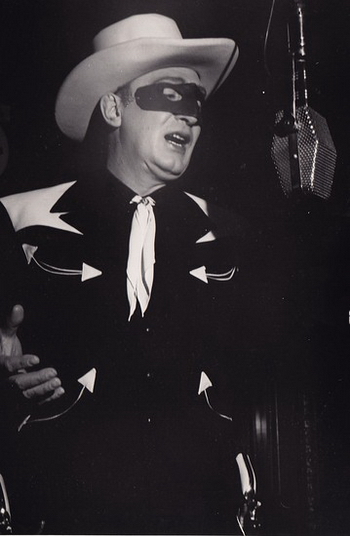|
"Hi-Yo Silver Awayyyy"
by Graham Newton
Earle Graser - was the voice of the Lone
Ranger
from 1933 until his accidental death
in 1941.
His "Hi-Yo Silver" was used
through the rest
of the radio series and on the
TV series.

|
|
...the quest for music used on The Lone Ranger.
The following highlights are from a well-
received program given by CAPS member
Graham Newton at the September meeting.
Radio shows from the Golden Age of broadcasting
often used a wide range of music to accent and
punctuate the drama being played out by the
actors. It was the music that gave a spine-chilling
quality to a murder mystery, or the feeling of
galloping across the plains on horseback, or even
the pathos of unrequited love. The Reader's Digest
once commented that "the definition of a classical
music 'snob', was someone who could listen to the
finale of Rossiniís William Tell Overture, and
NOT think of the Lone Ranger".
Few people know that the show producers
wrestled with what theme music to use, and had
considered the Light Cavalry Overture by Von
Suppe as a serious contender, but ultimately, to
their credit, they made the enduring choice
of the finale of the William Tell Overture that thrills
listeners everywhere to this day. For the first few
years, classical music was exclusively used on the
show for bridges from scene to scene as viewed by
your mind's eye. The music was mostly drawn
from the RCA Victor Red Seal classical music
library, and there was good reason... you didn't
have to PAY to use classical music... it was in the
public domain!
Finally, having settled on the finale of the William
Tell Overture as the show's theme, they used a
conventional commercial classical release for a
few of the early years of the show. Collectors
often sought the version of the William Tell
Overture as used on the Lone Ranger from 1940 to
the end of the run of the show. The actual version
evaded everyone until it was discovered that it,
and other music, was specially recorded in Mexico
for the show by RCA Victor's Thesaurus Division
in order to avoid the AF of M Musicians Union
strike called by the infamous James Petrillo. This
act left The Lone Ranger with the best music
library of any radio show, which remained in use
for the remaining years of the program, including
being bridged over to the black and white TV
show when the radio show ended.
Certain other classical music works played crucial
roles in the show, such as the first half "ender" and
second half "opener" which was taken from Liszt's
Les Preludes, the finale portion called "Strife and
Victory".
The REALLY striking mood music originated at
Republic Pictures in Hollywood, when in 1937,
George W. Trendle, the owner of The Lone Ranger
made a deal with them to produce two Saturday
matinee 12 chapter movie serials.
Trendle was not one to miss an opportunity, and he obtained some
of the raw Republic music tracks, used in the
films, to add some of the movie flavor to the
popular radio show. This was relatively short
lived when the threat of the musicians strike
loomed on the horizon.
Brace Beemer
- The best known lone-ranger of the
radio series,
was originally the Narrator of the series
eventually replacing Earle Graser, his run lasted from
1941 to 1954.

|
|
Being a lawyer, Trendle decided to put the Lone
Ranger music beyond the reach of the Musicians
Union and any music publishers that may be
involved. He went to the Thesaurus division of
RCA Victor (who were already pressing the 16"
transcriptions that the show was distributed on)
and had them slightly re-arrange the Republic
tracks to avoid any copyright issues. They then
took the music to Mexico where it was all newly
recorded and became the exclusive property of
The Lone Ranger, to do with as they pleased.
This music became the "stock" music library that all
Lone Ranger shows would draw upon until the end
of production in the mid-1950's.
The music had to set the mood of the scene being
described, and it all boils down to a few music
styles that are described by terms like:
Mysterioso -performed in a stealthy, mysterious
manner
Agitato -performed in a restless, excited manner
Furioso - performed in a wild passionate manner
Lamentoso - generally performed in a mournful
manner
Grandioso - in grand majestic manner
The Motion Picture industry added some of their
own descriptors.
Chase - a rapid movement typically in 4/4 time...
mostly for a horse chase
Hurry - similar to agitato, implying continuous
fast movement, like a car
Mood music works are often referred to as "cues"
because they are cues to the action of a film or
drama. You rarely hear it all, or in the clear, since
often only a small segment is needed to establish
the mood, and frequently the music is covered with
dialog and sound effects.
As used on the Lone Ranger show, mood music
helped bring to life the changing images in the
listeners mind. These little excerpts of music
became so well associated with the radio show
which used them, that hearing them can transport
you back to those "thrilling days of yesteryear"...
the days when radio was king. Other shows, which
used music extensively, included X Minus One and
The Silver Eagle (set in Canada). In the full text
version with the 53-minute CD, CAPS members
can enjoy hearing these and other excerpts from the
golden age of radio.
|